
Filipendula ulmaria, commonly known as meadowsweet or mead wort, is a perennial herbaceous plant in the family Rosaceae that grows in damp meadows. It is native throughout most of Europe and Western Asia. It has been introduced and naturalised in North America.

Mercurialis perennis, commonly known as dog's mercury, is a poisonous woodland plant found in much of Europe as well as in Algeria, Iran, Turkey, and the Caucasus, but almost absent from Ireland, Orkney and Shetland. A member of the spurge family (Euphorbiaceae), it is a herbaceous, downy perennial with erect stems bearing simple, serrate leaves. The dioecious inflorescences are green, bearing inconspicuous flowers from February to April. It characteristically forms dense, extensive carpets on the floor of woodlands and beneath hedgerows.

A leaf miner is any one of numerous species of insects in which the larval stage lives in, and eats, the leaf tissue of plants. The vast majority of leaf-mining insects are moths (Lepidoptera), sawflies, and flies (Diptera). Some beetles also exhibit this behavior.
Cadophora malorum is a saprophytic plant pathogen that causes side rot in apple and pear and can also cause disease on asparagus and kiwifruit. C. malorum has been found parasitizing shrimp and other fungal species in the extreme environments of the Mid-Atlantic Ridge, and can be categorized as a halophilic psychrotrophic fungus and a marine fungus.

Ascochyta sorghi is a fungal plant pathogen. It causes Ascochyta leaf spot on barley that can also be caused by the related fungi Ascochyta hordei, Ascochyta graminea and Ascochyta tritici. It is considered a minor disease of barley.
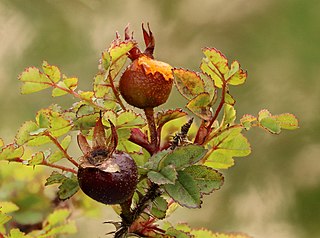
Phragmidium rosae-pimpinellifoliae is a species of fungus in the family Phragmidiaceae. A plant pathogen, it causes a rust on the stem, leaves, petioles and fruits of burnet rose and related hybrids. The fungus is found in Europe and North America.

Ambrosina is a genus in the family Araceae that consists of only one species, Ambrosina bassii, and the only genus in the tribe Ambrosineae. This species is the smallest terrestrial aroid in the Mediterranean, growing only to 8 cm tall. It is usually found growing in woodlands on north faces of hillsides and in humus soil that is covering limestone. It is distributed in Sardinia, Corsica, Sicily, southern mainland Italy, Tunisia, and Algeria.
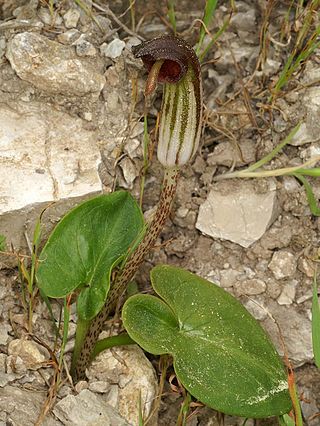
Arisarum is a genus of flowering plants in the family Araceae. It is native to the Mediterranean region, east to the Caucasus and west to Macaronesia.

Mercurialis annua, annual mercury, is a species of flowering plant in the spurge family Euphorbiaceae. It is native to the Middle East and the Mediterranean region, where it occurs on bare, sandy soils in semi-arid regions. Its seeds are dispersed by harvester ants, which remove an oily coating that delays germination. In recent centuries, annual mercury has spread to northern Europe and many other parts of the world as an agricultural and urban weed. It has been studied for its complex genetics and breeding system. It is named after the Roman god Mercury, due to its association with fertility.
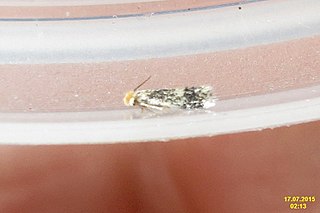
Ectoedemia hannoverella is a moth of the family Nepticulidae found in Asia and Europe. The larva mines the leaves of poplars causing a small gall in the petiole.

Phyllonorycter agilella is a moth of the family Gracillariidae. It is found in Latvia central Russia, Pyrenees, Italy and Bulgaria and from France to eastern Russia.

Phyllonorycter blancardella, the spotted tentiform leafminer, is a moth of the family Gracillariidae. It is known from all of Europe, east to Ukraine and central Anatolia. It is also known throughout North America including Nova Scotia, Quebec, Ontario, Wisconsin and California.

Elachista consortella is a moth of the family Elachistidae. It is found in most of Europe, except most of the Balkan Peninsula, Poland, Latvia and Finland.

Andricus aries is a species of gall-forming wasps, in the genus Andricus. The species was named by the French entomologist Joseph-Étienne Giraud, in 1859. It is commonly found in eastern Europe and during the 21st century has spread to western Europe.
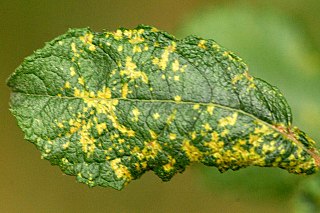
Melampsora caprearum is a fungal pathogen which causes galls on willows. Also known as a rust fungus, it was first described by Felix von Thümen in 1879.

Phytomyza stolonigena is a leaf mining fly in the family Agromyzidae, whose larvae burrow into leaves of Ranunculus. The larvae of the fly make characteristic mines in Ranunculus leaves; they mine in the petiole, making single corridors that fan out into the leaf blade.

Silene nivalis is a flowering plant in the pink family (Caryophyllaceae) native to Romania. A smut fungus, Microbotryum violaceum affects the anthers.

Podosphaera filipendulae is a fungal species that belongs to the genus Podosphaera and the order Erysiphaceae. It was first described with meadowsweet as the host plant.

Physodermatacae is a family of chytrid fungi in the order Physodermatales. Species in the family have a parasitic relationship with the host's physoderma. This family is distinctive in that it contains a thick wall around the sporangia to resist against unfavorable conditions. Sporangia releases from a host plant when rotting, dispersal is carried through the air. This family is not to be confused or related to basidiomycetes rusts and smut fungi. This parasite is distributed all across the world in aquatic, semi aquatic wetlands and in some ferns.
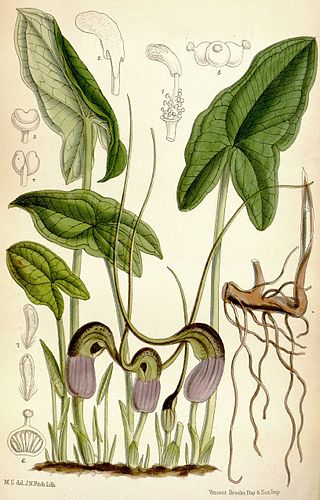
Arisarum proboscideum, also known as the mouse plant or mouse-tail plant, is a flowering plant in the family Araceae.




















